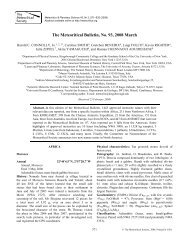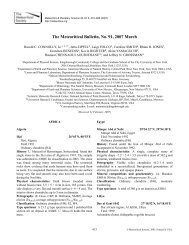Create successful ePaper yourself
Turn your PDF publications into a flip-book with our unique Google optimized e-Paper software.
578<br />
Table 5 Estimated composition of average “high-K” KREEP, as derived by Warren (1989).<br />
Warren<br />
and<br />
Wasson (1979b) KREEP<br />
It is expected/inferred that none of this material<br />
remains in its original form, since almost as soon<br />
as it formed it probably was massively involved in<br />
assimilative reactions with magnesium-rich magmas<br />
(Warren, 1988; Papike et al., 1996; Shervais<br />
and McGee, 1999). <strong>The</strong>re may even have been a<br />
tendency for KREEP to differentiate (albeit<br />
temporarily and locally) by silicate liquid immiscibility<br />
(Neal and Taylor, 1991; Jolliff et al.,<br />
1999). <strong>The</strong> few KREEP-rich rocks that are pristine<br />
are mostly basalts, or in rare cases granitic (Papike<br />
et al., 1998). Despite the ephemeral nature of the<br />
hypothetical urKREEP, it is useful to compare all<br />
other lunar sample compositions to the average<br />
composition of the most concentrated “high-K”<br />
variety of polymict impactite KREEP, which<br />
occurs among Apollo 12 and especially Apollo<br />
14 samples (Table 5).<br />
<strong>The</strong> <strong>Moon</strong><br />
Warren (1989)<br />
KREEP<br />
(avg. high-K)<br />
Strength<br />
of correlation<br />
with KR a<br />
KREEP/CI<br />
chondrites<br />
wt. ratio<br />
Most of the lunar meteorite highland regolith<br />
breccias, which come from widely scattered<br />
random points, are remarkably KREEP-poor<br />
compared to the Apollo and Luna regolith<br />
samples (Table 3). <strong>The</strong> recent Lunar Prospector<br />
maps of the global distributions of thorium,<br />
uranium, potassium, and samarium (Lawrence<br />
et al., 2002a; Prettyman et al., 2002; Elphic<br />
et al., 2000) revealed that the Apollo/Luna<br />
sampling region happens to be atypically<br />
KREEP-rich.<br />
<strong>1.21</strong>.4.2 Bombardment History of the <strong>Moon</strong><br />
Uncertainty<br />
class b<br />
(see below)<br />
Li mg g 21<br />
56 40 Moderate þ 25 III<br />
Na mg g 21<br />
6.4 7 Moderate þ II<br />
Mg mg g 21<br />
64 50 a<br />
Moderate 2 II<br />
Al mg g 21<br />
88 80 Weak 2 9.3 I<br />
Si mg g 21<br />
224 235 Weak þ (?) I<br />
P mgg 21<br />
3.4 3.5 Moderate þ 3.4 III<br />
K mgg 21<br />
6.9 8 Weak þ 14 III<br />
Ca mg g 21<br />
68 70 Weak 2 7.6 II<br />
Sc mg g 21<br />
23 23 None 4.0 II<br />
Ti mg g 21<br />
10 12 Very weak þ 29 III<br />
V mg g 21<br />
43 40 Weak 2 II<br />
Cr mg g 21<br />
1.3 1.2 Weak 2 II<br />
Mn mg g 21<br />
1.08 1.05 None II<br />
Fe mg g 21<br />
82 80 Weak þ II<br />
Co mg g 21<br />
33 25 Weak 2 IIII<br />
Ga mg g 21<br />
7.5 9 Weak þ (III)<br />
Br mg g 21<br />
Not estimated 120 Moderate þ IIII<br />
Rb mg g 21<br />
22 22 Weak þ 9.9 III<br />
Sr mg g 21<br />
200 200 Very weak þ 25 I<br />
Y mg g 21<br />
300 400 Strong þ 278 (II)<br />
Zr mg g 21<br />
1700 1,400 Strong þ 368 III<br />
Nb mg g 21<br />
80 100 Moderate þ 370 (III)<br />
Cs ng g 21<br />
2000 1000 Weak þ 5.46 III<br />
Ba mg g 21<br />
1200 1,300 Strong þ 565 II<br />
La mg g 21<br />
110 110 Very strong þ 466<br />
Ce mg g 21<br />
270 280 Very strong þ 455 I<br />
Pr mg g 21<br />
Not estimated 37 Very strong þ 398 I<br />
Nd mg g 21<br />
180 178 Very strong þ 389<br />
Sm mg g 21<br />
49 48 Very strong þ 322<br />
Eu mg g 21<br />
3.0 3.3 Moderate þ 59 I<br />
Gd mg g 21<br />
57 58 Very strong þ 294<br />
Tb mg g 21<br />
10 10.0 Very strong þ 282<br />
Dy mg g 21<br />
65 65 Very strong þ 265<br />
Ho mg g 21<br />
14 14 Strong þ 256 I<br />
Er mg g 21<br />
39 40 Very strong þ 250<br />
Tm mg g 21<br />
Not estimated 5.7 Very strong þ 231 I<br />
Yb mg g 21<br />
36 36 Very strong þ 226<br />
Lu mg g 21<br />
5.0 5.0 Very strong þ 204<br />
Hf mg g 21<br />
37 38 Strong þ 317 I<br />
Ta mg g 21<br />
4.0 5.0 Very strong þ 313 II<br />
W mg g 21<br />
2.0 3.0 Strong þ 30 (III)<br />
Th mg g 21<br />
18 22 Very strong þ 759 I<br />
U mg g 21<br />
5 6.1 Strong þ 744 I<br />
Molar Mg/(Mg þ Fe) 0.64 0.59 c<br />
Moderate 2 II<br />
a b<br />
Warren’s (1989) parameter KR is the average of sample/KREEP ratios for a large set of incompatible trace elements. Estimated uncertainties<br />
for the average high-K KREEP composition, expressed as maximum expected percentages of deviation between “true” average and estimates:<br />
blank ¼ 5%, I ¼ 10%, II ¼ 20%, III ¼ 30%, IIII ¼ 40%. Parentheses denote elements for which extrapolation to high KR is required.<br />
c<br />
Mg concentrations appear to be systematically higher in Apollo-14 KREEP versus KREEP from other locales.<br />
<strong>The</strong> polymict impactites are extremely important<br />
as primary constraints on the impact<br />
bombardment of the <strong>Moon</strong>. This bombardment





